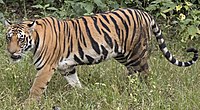
Photo from wikipedia
Abstract We conducted an exploratory serological survey to evaluate the exposure of Bornean wild carnivores to several viruses common to domestic felids, at interface areas between protected forest and industrial… Click to show full abstract
Abstract We conducted an exploratory serological survey to evaluate the exposure of Bornean wild carnivores to several viruses common to domestic felids, at interface areas between protected forest and industrial agriculture in the Kinabatangan floodplain (Sabah, Malaysia). Blood samples, collected from wild carnivores (n = 21) and domestic cats (n = 27), were tested for antibodies against feline coronavirus (FCoV), feline panleukopenia virus (FPLV), feline herpesvirus (FHV) and feline calicivirus (FCV), using commercial enzyme‐linked immunosorbent assay (ELISA) test kits. Anti‐FCoV antibodies were detected in most species, including one flat‐headed cat (Prionailurus planiceps, [1/2]), leopard cats (Prionailurus bengalensis, [2/5]), Malay civets (Viverra tangalunga, [2/11]) and domestic cats (Felis catus, [2/27]). Anti‐FCV antibodies were present in all domestic cats and one flat‐headed cat, while anti‐FPLV antibodies were identified in Sunda clouded leopards (Neofelis diardi, [2/2]), domestic cats [12/27] and Malay civets [2/11]. Anti‐FHV antibodies were only detected in domestic cats [2/27]. Our findings indicate pathogen transmission risk between domestic and wild carnivore populations at the domestic animal–wildlife interface, emphasizing the concern for wildlife conservation for several endangered wild carnivores living in the area. Special consideration should be given to species that benefit from their association with humans and have the potential to carry pathogens between forest and plantations (e.g., Malay civets and leopard cats). Risk reduction strategies should be incorporated and supported as part of conservation actions in human‐dominated landscapes.
Journal Title: Transboundary and Emerging Diseases
Year Published: 2022
Link to full text (if available)
Share on Social Media: Sign Up to like & get
recommendations!